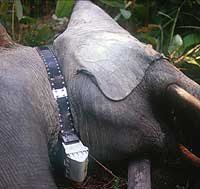Tracking Forest Elephants with GPS
The union of technology and the environment is key to protect some of Africa's most fragile ecosystems that are falling victim to unsustainable timber exploitation, shifting cultivation, urban expansion, and additional human threats. In this case, I am referring to the forested landscapes throughout the Congo Basin. Yet in order to protect and preserve the environment, there is still so much more to learn about the ecosystem and its natural residents. One of the more elusive residents of the Congo Basin is the forest elephant. The Wildlife Conservation Society has been working hard and connecting with universities in the United States to develop and utilize technology to get at some of the answers needed to initiate conservation activities.
What is GPS?
GPS stands for Global Positioning System. It is a suite of satellites run by the U.S. Department of Defense that orbits the Earth. At any location on the globe, there will be at least four satellites that can "beam" a signal to a device that can fit in the palm of your hand. The device, or GPS receiver, can then display your position as latitude and longitude and elevation. GPS technology is utilized by hikers, surveyors, airline pilots, and yes, you may find GPS in your car. But scientists are very interested in learning how GPS can be applied to biodiversity and conservation studies.

Forest elephant wearing a GPS collar. Source: Smithsonian National Zoological Park.
Why track forest elephants?
One third of the 500,000 elephants on the African continent are considered forest elephants. Compared to their savanna elephant cousins, the forest elephants are smaller and adapted to living in dense forests. Unfortunately, because of the difficulty in tracking elephants through heavily forested areas, not much was known about this endangered species. But by attaching GPS collars to these elephants, scientists can easily track elephants and learn about timing and distance of movements. For example, it was recently discovered that forest elephants can have a home range of about 1,243 square miles (2,000 km).
Where do the elephants go?
As of 2006, 36 elephants have been collared in six of Africa's National Parks. Only one complete dataset exists at present, from Nouabalé-Ndoki, in Congo, where a female and her calf had a home range of over 2250 sq. km. Over half of central Africa's national parks are smaller than this. Forest elephants travel linear distances in excess of 100 km, crossing park boundaries and international borders frequently. One large bull crossed the entire Nouabalé-Ndoki National Park in just three days! Forest elephant movements are most strongly determined by the distribution of water, fruit, mineral deposits, and, most importantly, human activity.